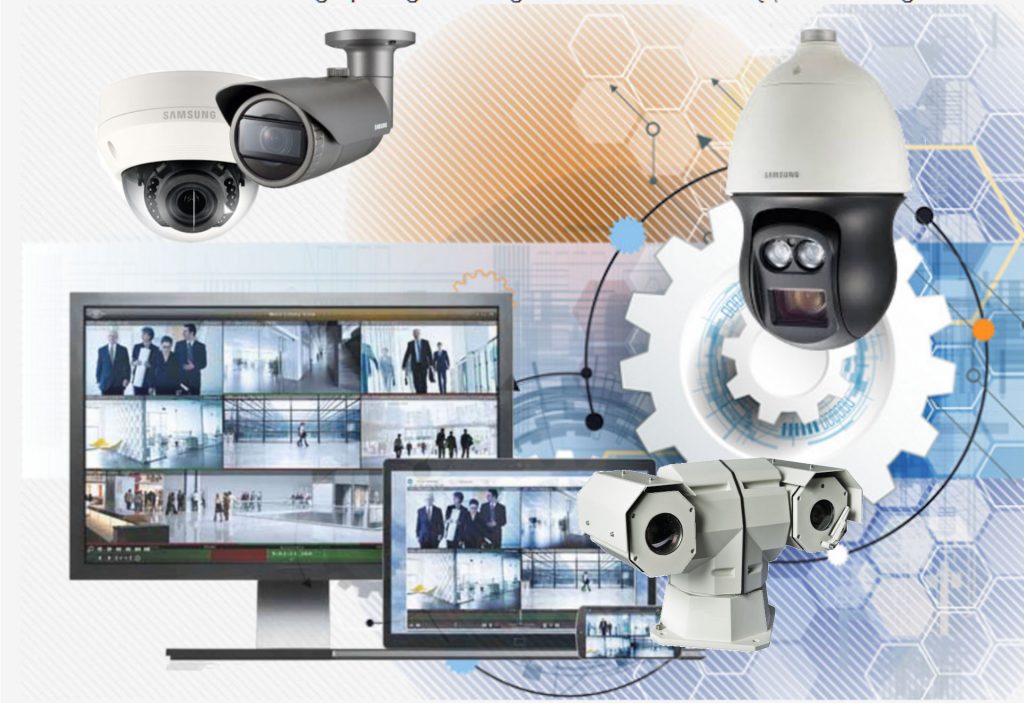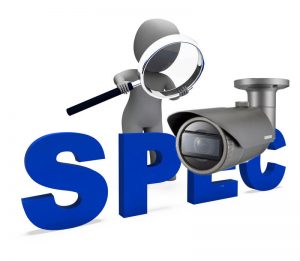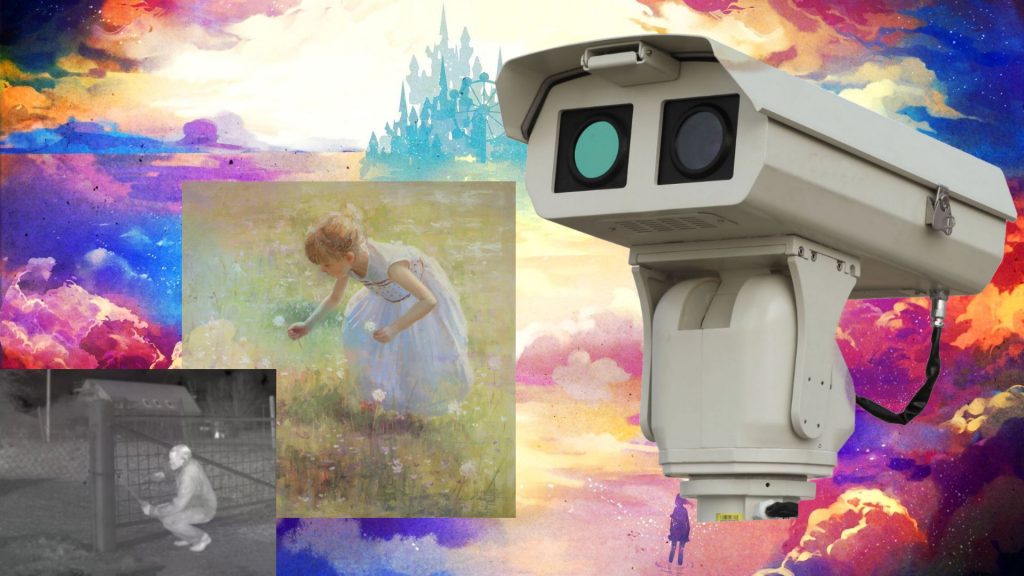Everything you wanted to know about IP camera systems
So you would like to purchase an IP camera system. You may have some idea about your goals. But, are those expectations realistic?
The more you know about the capability of the IP camera system, the better you can select the system that meets your expectations.
This technical summary provides the information you need to make an informed purchase of your IP camera system.

How the IP Camera System Works
IP cameras consist of a lens, sensor, video amplifier, microcomputer and network interface that connects the camera to the network. A complete IP Camera System includes recording software.
The latest security camera systems can also include intelligence. AI-enhanced cameras and software automatically detect threats and provide alarms that prevent dangerous situations from becoming critical. This AI technology offers a paradigm change in the usage of IP Camera Systems. Read more about AI-enhanced camera systems.
The sensor of the camera defines the resolution. A good lens is also required to make sure the picture is clear. Some inexpensive cameras have mega-pixel sensors, but the lens is so bad that the picture looks fuzzy. The electronics also helps provide a clear video signal. It assures that you can see not only in bright sunlight but also when it gets dark. Some camera can see things at night that our eyes can’t see.
To learn more, look at our video, How the IP Camera Works.
The IP camera systems also include the video recording system. There are a number of different recording systems including special video management software (VMS), network video recorders (NVR), and cloud recording systems. See below for more about recording the video from your IP camera system.
Understanding IP Camera Specifications, What’s Important
IP Camera specification sheets help you select the right camera for your IP security and surveillance system. But, which specifications are important? The important specifications for an IP camera include resolution, minimum light sensitivity, lens, WDR, signal to noise, etc. It is important to know how to avoid being fooled by specsmanship (from the marketing department).

One example, of confusing specifications, is the resolution definition. In the old days, the resolution was measured in TV lines, and they used a TV test pattern to analyze the resolution. Today resolution is defined by the total number of pixels in the sensor or the horizontal and vertical pixels.
Marketing people also use the term “HD” and “720p” or “1080p”, and most recently “4K”. 720p cameras have at least 720 vertical lines (or pixels). Remember, IP cameras are defined by the number of horizontal and vertical pixels and not scan lines. It can be very confusing.
Resolution of IP Camera Systems
720p cameras usually have a sensor with at least 1.0 megapixels. For example, the Sony SNC-EM600 has a resolution of 1280 x 1024 (or 1.3-megapixel sensor), The Axis M3044V 1.0-megapixel camera has only 1280 x 720 pixels. Most professional IP cameras provide at least 2.0-Megapixel resolution.
The 1080p cameras have at least a 2-megapixel sensor, and it is considered to be the higher resolution “HD camera.” To confuse us, some manufacturers specify their 3-megapixel or 5-megapixel camera as “1080P” as well.
4K Camera: This usually refers to an IP camera with at least 4,000 vertical lines. Unfortunately, some manufacturers claim 4K-resolution but provide less resolution. For example, Axis introduced a camera with 3840 x 2160 which they call Ultra HD. The Hanwha (Samsung) PNO-9080R has a resolution of 4000 x 3000 pixels. The Sony 4K IP camera has a chip with 4096 H × 2160 V pixels which run at up to 60 fps and conforms to the Digital Cinema Initiative. The marketing people call all these cameras “4K”.
To learn more about other things that affect what you can see such as minimum low light sensitivity, clarity of the lens, and wide dynamic range look at our article describing all the important IP camera specifications.
Low-Light Sensitivity of the IP Camera
The low-light sensitivity of the camera is a significant specification. The low light sensitivity of an IP camera is affected by amplifier gain, low signal to noise amplification, iris control, day/night filter, frame rate, and shutter speed. In some applications, it can also help to select a camera with a built-in IR illuminator. (See below for more about adding light).
The resolution will sometimes affect the low-light capability of the IP camera. Usually, the 2-Megapixel cameras will provide better low-light capability than the 5-Megapixel cameras.
For more information, take a look at our article about How to Set Up an IP Camera for Low Light Situations.
The Lens for Your IP Camera System
If you have cameras located in different locations and are viewing different things, you probably need different lenses. Many IP cameras come with a lens, so you need to select the right camera and lens system. If you are viewing a parking lot you will need a different lens than one used to view a small room. The field of view defines how wide an area you can see, and the zoom or magnification of lens will determine how far away you can see.
For more information about how the lens affects what you can see with your IP camera system, take a look at our article Calculating What You Can See with Your IP Camera.
Defining Your Objectives for the IP Camera System
Before you select your IP camera system, you need to determine what your objectives are. Your objectives can be different for each area that you want to monitor.
For example, the purpose of your IP camera surveillance system can include increased safety, reduced theft, improved productivity, or reducing liability. It also includes how quickly you need to be notified of an alarm condition. For example, the latest intelligent IP cameras provide advanced analytics that provides immediate notifications if they see a person crossing a line, leave a package, or take a package. They can even let you know if they hear a person screaming or a gunshot. For more about cameras with analytic capability, take a look at our article, The Intelligent IP Camera.

Knowing your objectives helps you determine the right camera. It will help you choose the right resolution, the best lens, the low-light capability, or whether or not you need wide dynamic range (WDR). You may also need audio capability, analytic functions, special inputs, and outputs. You also can select the best video recording and management system. Of course, we can always help you select the right components for your IP camera system.
Each type of situation can affect the final camera system specifications we need. To learn more about setting objectives, look at our article about Defining Your Objectives. It includes discussions about reducing liability, catching criminals, improving productivity, controlling door access, validating a remote alarm, and even viewing animals in the wild.
What Can You See with Your IP Camera System?
It is important to understand what you can see with your IP camera. Can you see the target when it’s dark? How far away is the object? What detail do you need? We can predict the performance of the IP camera system by knowing the specifications of the camera and the lens.
The magnification of the lens determines how far away you can see. The detail you can see is determined by the resolution of the camera. The article Calculating What You Can See With Your IP Camera describes how to calculate the performance of the IP camera.

Some cameras are capable of low-light operation and can add IR illumination for viewing in total darkness. The thermal imaging camera can be used to see far away in total darkness. The article Detection, Recognition, Identification: The New Criteria, describes what we need to detect an object, or to recognize what it is, or to identify the person.
Long range IP camera systems provide the ability to see things that are many miles away. There are some medium range systems that can detect an object that is about two miles away. Specialized custom made long-range PTZ cameras can detect targets that are over 10 miles away. Take a look at our article Comparison of Long Range IP Camera Systems that describes the capability of different long-range camera systems.
Video Recording for IP Camera Systems
Whatever IP camera you get, you will also need some way of recording the video and managing the cameras. The video management system provides many functions. It records the video when you want it to be recorded. Sometimes we only record when an alarm condition is detected such as motion detected. In other cases, we want to only record over a specific time period. We may want to record the video at night and holidays. The video management software (VMS) allows us to set many different conditions for recording as well as when the security person should be alerted.
Some of the video recording systems also include integration with other systems such as door access control. Take a look at our article, How to Integrate IP Camera Systems with Door Access Systems.
There are three types of IP camera recording systems to consider. Each one provides some unique capability.
- Video Management Software
- Network Video Recorder
- Cloud service systems
To learn more about the video recording systems, take a look at our Video Recording Systems summary.
What is the Best IP Camera System
The best IP camera system depends on your own requirements. You may require increased safety, or reduce theft. You may want to improve productivity or reduce liability. One very important consideration is how quickly you need to be notified of an alarm condition. Do you want to be notified when a person steals the laptop from the desk or leaves an unattended package, or do you need to record what happens in the parking lot?
Once you have answered these questions you can select a low-cost camera system or one that includes a special zoom lens. You may want an IP camera system to watch a small room or a road that is 5 miles away. If you need to see a very wide area with very good resolution, you can select an IP camera system with 4K resolution.
For help in selecting the right IP camera system for your application, take a look at our article, What is the Best Camera for IP Camera Systems.
Summary of IP Camera System Technology
IP camera systems can provide surveillance, notification of alarms, reduction in insurance costs, stop unwanted entry, or increased productivity. Once you understand your objectives and understand how IP camera systems work, you can select the right IP camera system for your requirements.
If you need help specifying your IP camera system, please contact us at 800-431-1658 in the USA, or at 914-944-3425 everywhere else, or use our contact form.